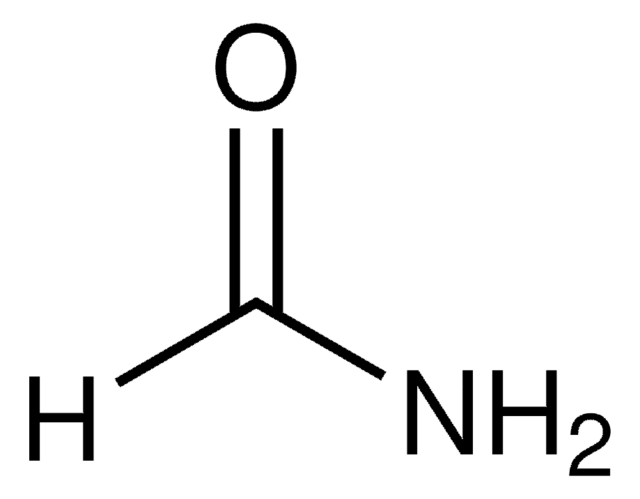47671
Formamida
BioUltra, for molecular biology, ≥99.5% (T)
Sinónimos:
Amida fórmica, Amidas C1
About This Item
hybridization: suitable
protein extraction: suitable
30 mmHg ( 129 °C)
Productos recomendados
grade
for molecular biology
Quality Level
vapor density
1.55 (vs air)
vapor pressure
0.08 mmHg ( 20 °C)
30 mmHg ( 129 °C)
product line
BioUltra
assay
≥99.5% (T)
form
liquid
autoignition temp.
932 °F
technique(s)
FISH: suitable
hybridization: suitable
protein extraction: suitable
impurities
DNases, none detected
RNases, none detected
insoluble matter, passes filter test
phosphatases, none detected
proteases, none detected
ign. residue
≤0.1%
refractive index
n20/D 1.447 (lit.)
n20/D 1.447
pH
7-9 (25 °C, 1 M in H2O)
bp
210 °C (lit.)
mp
2-3 °C (lit.)
solubility
H2O: 10 M at 20 °C, clear, colorless
density
1.134 g/mL at 25 °C (lit.)
anion traces
chloride (Cl-): ≤1 mg/kg
sulfate (SO42-): ≤10 mg/kg
cation traces
Ag: ≤5 mg/kg
Al: ≤1 mg/kg
As: ≤0.1 mg/kg
Ba: ≤1 mg/kg
Bi: ≤1 mg/kg
Ca: ≤5 mg/kg
Cd: ≤1 mg/kg
Co: ≤1 mg/kg
Cr: ≤1 mg/kg
Cu: ≤1 mg/kg
Fe: ≤1 mg/kg
K: ≤20 mg/kg
Li: ≤1 mg/kg
Mg: ≤1 mg/kg
Mn: ≤1 mg/kg
Mo: ≤1 mg/kg
NH4+: ≤1000 mg/kg
Na: ≤20 mg/kg
Ni: ≤1 mg/kg
Pb: ≤1 mg/kg
Sr: ≤1 mg/kg
Tl: ≤5 mg/kg
Zn: ≤1 mg/kg
SMILES string
NC=O
λ
10 M in H2O
UV absorption
λ: 260 nm Amax: ≤0.4
λ: 280 nm Amax: ≤0.1
application(s)
genomic analysis
InChI
1S/CH3NO/c2-1-3/h1H,(H2,2,3)
InChI key
ZHNUHDYFZUAESO-UHFFFAOYSA-N
¿Está buscando productos similares? Visita Guía de comparación de productos
General description
Application
- as a component in the hybridization buffer for in situ hybridization as a component of solution X to wash the slides to remove the coverslips
- in the preparation of denaturation solution for spectral karyotyping (SKY) analysis
- in the preparation of 1% formaldehyde solution for the pretreatment of slides for comparative genomic hybridization (CGH)
- to prepare pre-hybridization buffer I, II, III, IV, and hybridization buffer I, II, and III for RNA fluorescence in situ hybridization (RNA-FISH)
- as an ionizing solvent in the production of formic esters and vitamin, a softener for paper, in animal glues, and water-soluble gums, in molecular biology as a denaturing agent
Biochem/physiol Actions
Features and Benefits
- Versatile and adaptable for a wide variety of laboratory and research applications
- BioUltra Grade for your Molecular Biology, Cell Biology and Biochemical research
- Tested to confirm low levels of heavy metal contamination, ensuring suitability for various applications
- Free from DNase, RNase, NICKase and proteaseTested for trace levels of Anions and Cations
Other Notes
signalword
Danger
hcodes
Hazard Classifications
Carc. 2 - Repr. 1B - STOT RE 2 Oral
target_organs
Blood
Storage Class
6.1C - Combustible acute toxic Cat.3 / toxic compounds or compounds which causing chronic effects
wgk_germany
WGK 1
flash_point_f
305.6 °F
flash_point_c
152 °C
ppe
Eyeshields, Gloves, type ABEK (EN14387) respirator filter
Elija entre una de las versiones más recientes:
¿Ya tiene este producto?
Encuentre la documentación para los productos que ha comprado recientemente en la Biblioteca de documentos.
Protocolos
GC Analysis of Class 2 Residual Solvents on OVI-G43
Nuestro equipo de científicos tiene experiencia en todas las áreas de investigación: Ciencias de la vida, Ciencia de los materiales, Síntesis química, Cromatografía, Analítica y muchas otras.
Póngase en contacto con el Servicio técnico






